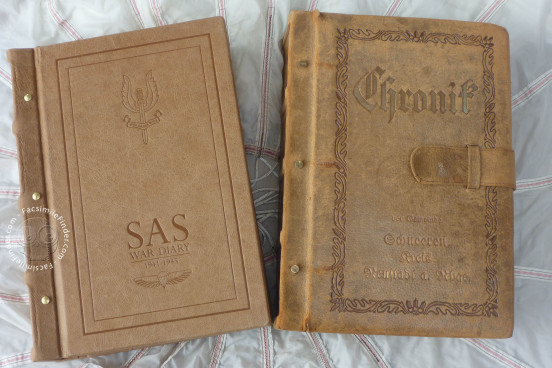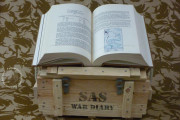Created in 1946 and kept secret ever since, the Diary is one of the most astonishing manuscripts to come out of the Second World War.
It is the personal and private history of the Regiment from the inside, by the SAS for the SAS, in their own words.
It contains an unparalleled collection of documents, reports, photographs and maps and tells for the first time the full story of the SAS during World War 2.
The story of the Diary
In early 1946, a former SAS soldier tasked himself with one final mission. The SAS had been disbanded and there were no plans to resurrect it. The soldier’s self-appointed mission was simple: to find and preserve whatever documentation he could before the SAS was forgotten and its story lost for ever.
The soldier tracked down the Top Secret order authorising the first ever SAS operation; he sought out photographs of the original members of 1 SAS, including men lost on that first operation; he somehow acquired the after-action reports from the few who survived.
Then with more photographs, operational orders and reports (all Top Secret), and a handful of newspaper articles from Britain and even America, he traced the story of the SAS through North Africa, Sicily, Italy and France, on to the drive through Europe for Berlin, until the final march past when the SAS was stood down.
By mission end, the soldier had produced something unique – the first ever history of the SAS, collated by an SAS man. Not only that, in the event of the SAS being consigned to a footnote in history, and with many of the documents he had copied either destroyed or lost forever, he had saved the story of the SAS during World War 2.
But the soldier did something else. He collated his work in a single massive war diary, measuring 17” x 12” x 4” and weighing over 25 lbs, and bound it in leather “liberated” from Nazi Germany. Without knowing it, the soldier had created an icon. Shortly before his death, he visited the SAS Regimental Association, and gave them… The SAS War Diary.
The Association locked The Diary away in its archives and its existence remained a secret.
Contents
Operational reports including:
- L Detachment SAS through the Western Desert
- David Stirling’s capture
- SRS operations in Sicily and Italy
- 1 SAS in France for D Day, NW Europe and Germany
- 2 SAS operations in Sicily, Italy, France for D Day
- Northern Italy post-D Day.
Over 25 maps and 300 photographs, many of them taken on operations and behind-the-lines.
David Stirling’s personal confidential memorandum on how he created the SAS.
Secret correspondence discussing the future of Special Forces in the Middle East.
Top Secret correspondence between Stirling and Prime Minister Winston Churchill on the future and importance of the SAS.
The order assigning SAS regimental status.
We have 7 facsimiles of the manuscript "SAS War Diary. 1941-1945":
- SAS War Diary. 1941-1945 - The Exemplary Edition facsimile edition published by Extraordinary Editions, 2011
- SAS War Diary. 1941-1945 - The Navigator's Edition facsimile edition published by Extraordinary Editions, 2011
- SAS War Diary. 1941-1945 - The Originals Edition facsimile edition published by Extraordinary Editions, 2011
- SAS War Diary. 1941-1945 - The Veteran's Edition facsimile edition published by Extraordinary Editions, 2011
- SAS War Diary. 1941-1945 - The Victoria Cross Edition facsimile edition published by Extraordinary Editions, 2011
- SAS War Diary. 1941-1945 - The Anniversary Edition facsimile edition published by Extraordinary Editions, 2011
- SAS War Diary. 1941-1945 - The Services Edition facsimile edition published by Extraordinary Editions, 2011



